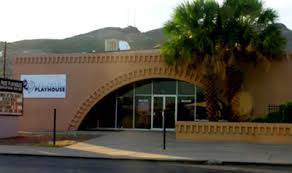1919: The newly formed El Paso Municipal Theater Association was putting on plays and showcasing local talent at El Paso High School. It appeared to have not lasted too long.
1921: The El Paso Women’s Club drama club was reestablished by Mrs. Warren Small and Mrs. Jerome Dale. It had a membership of 75, mostly young girls, who trained and met to read and study drama. The group put on three acts plays that they performed at the Hotel Cortez and at the Women’s Club Auditorium, who sponsored the plays and provided staging and lighting. It had an urgent need for male actors and wanted a professional director. The group put on a play titled Outward Bound directed by El Paso veteran, Joe Friedkin. Friedkin was a member of the Townsend players. In 1928, the women’s study group, with sponsorship of the El Paso Women’s Club, founded the El Paso Little Theater. They performed at the Hotel Cortez and Women’s Club auditorium until they moved into their own building on Trowbridge in 1933. The Little theater was part of a national movement. The idea was to get away from the theater that was larger scale, commercial based, and for profit. It was also aimed at sparking community interest in theater and developing local talent. It offered various ways for the community tp get involved. These theaters were laboratories in which to experiment and development new dramas for an ever-changing audience. In 1939, The Little Theater reorganized into the Community Theater of El Paso Inc. and moved into a new building on 1120 E. Yandell, which later became the Yandell Movie Theater.
1934: The Curtain Club was organized and performed dramas at the old community hall of Mt. Sinai.
1946: The El Paso Civic Players was organized and reorganized as the El Paso Players in 1947. They performed at the Old Catholic Community Center, now Cathedral High school, until the group faded out in 1955.
1951: The El Paso Playhouse was organized by Lois Kibbee with support from her mother. Their first play was Born Yesterday, performed at the Scottish Rite Temple. The purpose was to put on national plays and movies and apply them to a local production. The playhouse was first called El Paso Playhouse 51, then Playhouse 52. In 1952, it performed vaudeville type melodramas at the Hacienda Café to raise money to move into the old Phoenician Club on Kentucky street. These performances became an annual fundraiser. Howell Eurich, Pappy Clark, Jack Graf, and Polly Harris used to perform there. Polly Harris directed summer melodramas with Eileen Light at Hacienda. In 1953, the El Paso Playhouse 52 reorganized into the El Paso Playhouse Inc. The El Paso Playhouse moved into the old Mt Sinai Temple on 6201 North Oregon until they lost the building in 1963.
1956: A group of young aspiring actors founded the “Artist’s Supper Theater” and started performing at the Hacienda Café.
1965: Eurlich, Clark, Graf, and Cathy Franco saved the old Texas Avenue fire station and turned into a turn of the century theater that continued the tradition started by the El Paso Playhouse.
1958: Lois Kibbee, who was resident director, left El Paso Playhouse to seek a career in Hollywood. Her exit left a void, and no strong leader emerged who could unite the different theatrical fractions.
1963: Polly Harris and others broke off and organized the Las Americas Civic Theater which performed at the Old Liberty Hall. It lasted for a year.
1964: The El Paso Playhouse moved into John Alexander‘s Gay Nineties Club on 620 North Oregon and reopened in January of 1964 as the theater. Its first production was Around the Moon. Another group called the El Paso Civic Theater was formed and was able to move into the current playhouse location on 2501 Montana.
1965: The El Paso Civic Theater was evicted in 1964, and the building was remade into the Festival Theater. Its first production was Under the Yum Yum Tree. It had an acting school and also had a contract to put on productions at The Chamizal Theater in 1973 and 1974.
1968: The Festival Theater lost the building and moved into the second floor at the Toltec Building. It reopened as the Upstairs and Downstairs Theater.
1969: The first Chicano theater in El Paso, Teatro Los Probes Bilingual Theater, was founded by UTEP English Professor Joan Quarm. They produced Paso Del Norte which later turned into Viva El Paso. It was renamed the Southwestern Repertory Theater in the 1980s. After Quarm, Hector Serrano took over, and he was one of the creators of Viva El Paso and Paso Del Norte.
1975: Los Teatro Los Pueblos Bilingual Theater opened at the Chamizal Civic Theater.
1978: Leon Gillespie Steak’s House in five points was turned into the Green Room Dinner Theater. It opened in August of 1978.
1979: The Upstairs and the Festival theaters merged with each other becoming the El Paso Playhouse we know today.
1981: Six people, including Bill Logan, started the Music Theater of El Paso. Their goal was to put on local musical productions. They first performed Cabaret in May of 1982 at the Chamizal Theater. It was a standing room only performance.
1983: The UTEP Dinner Theater was founded by students Gregory Taylor and Jimmy Legarrela. The first production was Joseph and the Amazing Technicolor Dreamcoat on May 10, in the old student union ballroom. They were given $1,000 by the UTEP Special Programs and Activities Committee. It was called Union Dinner Theater and renamed the UTEP Dinner Theater in 1999. After two sold old performances, Taylor was given a work-study position to keep the theater going. It became part of the UTEP Department of Theater and Dance.
Joseph Longo
EPHS Volunteer

